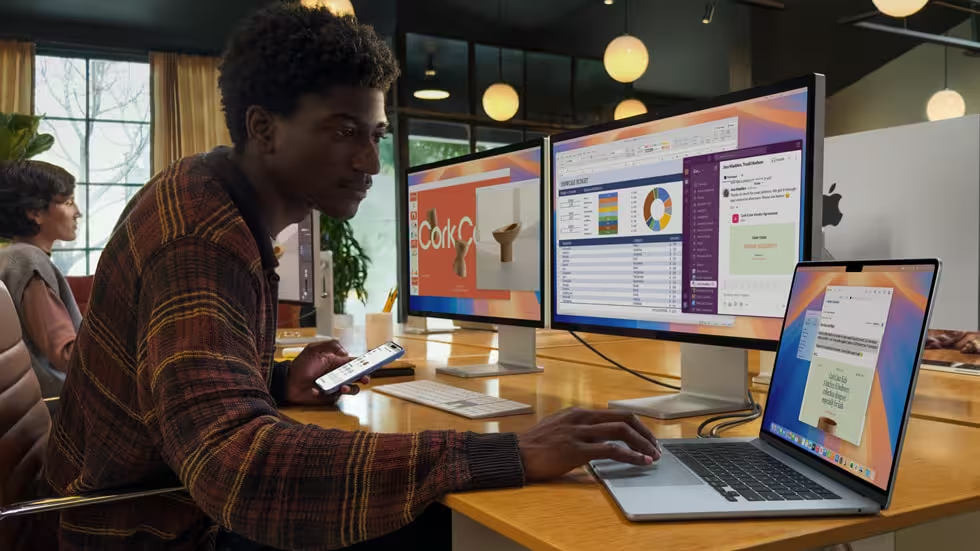The Technology Choice That's Reshaping Employee Loyalty
In today's competitive talent market, UK businesses face a stark reality: replacing an employee earning £25,000 costs an average of £30,614. Yet a surprisingly simple factor influences whether employees stay or leave, the technology they use every day.
Recent research from IBM reveals something remarkable: employees using Mac computers are 17% less likely to leave their company compared to those using Windows devices. For a 100-person organisation, this translates to keeping three additional employees annually, a potential saving of nearly £92,000.
But why does device choice matter so much? The answer lies in a powerful combination of productivity, autonomy, and daily experience that shapes how employees feel about their workplace.
The Numbers Tell a Compelling Story
IBM didn't arrive at their 17% retention advantage through speculation. Their analysis of employee behaviour patterns across thousands of workers revealed consistent trends:
These aren't marginal differences—they represent fundamental shifts in how employees experience their work environment.
Why Employee Choice Programmes Drive Loyalty
The concept of letting employees choose their work technology has emerged as a critical retention strategy. Research shows that 75% of employees are more likely to stay at a company offering device choice programmes.
When given options, the preference is clear: 72% of workers actively choose Mac over other devices. Perhaps most telling, 89% of employees would be willing to make salary sacrifices to receive their preferred work device.
For millennials who will comprise three-quarters of the workforce by 2025, this matters even more. 71% state that technology provision influences their employment decisions.
What This Means for UK Businesses
Recent UK-specific research reveals the urgency: 94% of UK employees are frustrated by inadequate workplace technology, with over half reporting stress and nearly half citing negative mental health impacts. More than 30% have considered leaving jobs purely due to poor digital experiences.
Employees are losing nearly an hour weekly to technology issues, translating to billions in lost UK productivity. Device choice programmes aren't just perks, they're retention tools addressing genuine pain points.
The Productivity Connection That Creates Loyalty
Higher retention rates correlate strongly with productivity outcomes. A comprehensive study found that 97% of respondents reported improved productivity when using Mac, while:
These productivity gains create a positive feedback loop. Employees feel more competent and engaged in their roles, naturally increasing their commitment to the organisation.
Reduced Support Burden Improves Daily Experience
One often-overlooked retention factor is the daily friction employees experience with technology. Mac devices require significantly less IT support, which directly enhances the employee experience.
IBM's data reveals they manage 7 engineers per 200,000 Mac devices versus 20 engineers needed for the same number of Windows machines. This reduced support requirement means employees experience fewer technology-related frustrations and interruptions.
Migration processes also matter: nearly 98% of Mac users report that migration processes are simple, compared to 86% migrating from Windows 7 to Windows 10. This reduces onboarding stress and accelerates productivity for new hires.
Real-World Implementation Success
The retention benefits aren't theoretical—organisations worldwide demonstrate measurable improvements:
SAP's Choice Programme
SAP's Mac choice programme resulted in over 30,000 employees choosing Apple devices, with the company maintaining a 94% retention rate. The programme enabled zero-touch deployment and reduced IT management overhead whilst improving employee satisfaction.
Siemens' Employee Experience
After implementing their Mac service programme, Siemens reported an 80% increase in employee satisfaction. More remarkably, 98% of employees appreciated having the choice of Mac devices, with 87% rating their Mac experience 4 or 5 out of 5 points.
Apple Retail's 81% Retention
Apple achieved an impressive 81% retention rate at their retail stores, with employee feedback indicating they felt more connected and valued, partly due to the technology ecosystem they worked within.
The Financial Case for UK Organisations
Forrester research indicates that organisations moving to Mac experience a 20% improvement in staff retention rates. Let's translate this into real numbers for a typical UK business:
Example: 100-Person Organisation
These savings compound over time as positive workplace culture develops around technology empowerment. Employees become advocates, improving recruitment outcomes and reducing time-to-productivity for new hires.
Why This Matters for Recruitment Too
Retention improvements create recruitment advantages. When employees actively recommend their workplace based on technology experience, organisations access higher-quality candidates who require less convincing.
In competitive sectors where talent acquisition costs exceed £10,000 per hire, this recruitment efficiency represents substantial value beyond direct retention savings.
Implementing an Effective Device Choice Programme
For UK organisations considering device choice programmes, success requires more than simply offering options:
1. Genuine Choice
Employees must feel their preferences are respected, not merely tolerated. This means supporting chosen devices properly, not creating two-tier support systems.
2. Robust Management
Modern device management platforms enable consistent security and compliance across diverse device fleets, removing traditional barriers to choice programmes.
3. Clear Communication
Employees need to understand available options, support structures, and how to make informed choices based on their work requirements.
4. Measurement
Track retention rates, satisfaction scores, and productivity metrics to demonstrate programme value and identify improvement opportunities.
The Broader Implications for Workplace Culture
Device choice programmes signal trust and respect for employee preferences. This symbolism extends beyond technology, it influences how employees perceive their value to the organisation.
When businesses invest in employee-preferred technology, they communicate: "Your productivity matters. Your preferences matter. Your experience matters." These messages resonate deeply in retention decisions.
Looking Forward: Technology as a Retention Strategy
As UK businesses navigate talent shortages and increasing turnover costs, technology choice emerges as an underutilised retention lever. The 17% improvement in retention rates that IBM documented isn't just a statistic—it's a roadmap to measurably better employee loyalty.
For organisations struggling with talent retention in competitive markets, Apple device programmes offer a tangible differentiator backed by concrete evidence. The question isn't whether technology choice affects retention—the data conclusively shows it does. The question is whether your organisation will leverage this insight before your competitors do.
Key Takeaways for UK Business Leaders
The technology employees use daily shapes their workplace experience, productivity, and ultimately, their decision to stay or leave. For forward-thinking UK organisations, Apple device programmes represent both a retention solution and a competitive advantage in an increasingly talent-conscious business environment.



